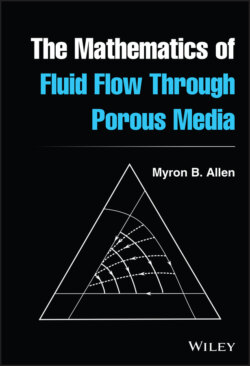Читать книгу The Mathematics of Fluid Flow Through Porous Media - Myron B. Allen III - Страница 30
2.5.1 Constituents
ОглавлениеThe first step in extending the mechanics of single continua is to consider a set of bodies , , called constituents. For example, in a porous medium, rock and water can be constituents. We postulate that each spatial point can be occupied by particles from every constituent. In this sense, the bodies constitute overlapping continua. This postulate clearly fails at scales of observation at which the constituents appear to occupy distinct regions of space. But for many natural porous media found in Earth's subsurface, the postulate yields reasonable models at scales of observation greater than about m.
Paralleling the development for single continua, for each constituent , we fix a reference configuration that assigns, to each particle in , a point in three‐dimensional space. The vector serves as a label for the particle. We denote by the region in three‐dimensional Euclidean space occupied by all of these vectors for the constituent .
We also associate with each constituent a one‐parameter family of mappings from to three‐dimensional Euclidean space such that:
1 The vector , having dimension L, gives the spatial position of the particle at time , as illustrated in Figure 2.11.
2 At each time , the function of the coordinate is one‐to‐one, onto, and continuously differentiable with respect to .
3 Also at each time , has continuously differentiable inverse such that . That is, tells us which particle from constituent occupies the spatial position at time .
4 For each value of the coordinate , the function is twice continuously differentiable with respect to .
We call the deformation of constituent .
Figure 2.11 A reference configuration and the deformation at times and for constituent in a multiconstituent continuum.
As in the single‐continuum case, the referential or Lagrangian velocity of is
To find the velocity of constituent at a fixed spatial point at time , we first find the particle that occupies at time , then compute the spatial or Eulerian velocity:
We associate with each constituent a material derivative, which gives the time rate of change following a fixed particle . For functions of , the material derivative is simply the partial derivative with respect to :
For functions of , an application of the chain rule similar to that employed in Section 2.1 for simple continua yields
